
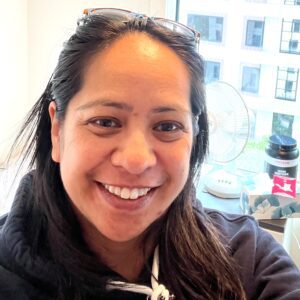


Ko tōu reo, ko tōku reo
Te tuakiri tangata
Tīhei uriuri, tīhei nakonako
Your language and my language are expressions of identity.
May our descendants live on, and our hopes be fulfilled
—
Ko Whatiri tōku maunga
Ko Waipao tōku awa
Ko Ngāpuhi tōku iwi
Kei te Whanganui-a-tara tōku kainga
Ko Frank rāua ko Kathy tōku mātua
Ko Lachlan tōku hoa Rangatira
Ko Harrison rāua ko Joshua āku tama
He māmā, he kaiako, he kaimahi hoki ahau o te NZEI Te Riu Roa
Ko Celeste Hawkins ahau
—
My journey and personal relationship with my identity is an ever-evolving part of my life. My identity bears the impacts of Te Tiriti o Waitangi and the Treaty from before I was even born.
I whakapapa Māori and my mother attended a native school where she was beaten for speaking te reo Māori. Her knowledge and memories of schooling are based on her being told and feeling like their language and culture held no value. Fast-forward to her older teen years: my mum moved to Te Whanganui-a-Tara from Te Tai Tokerau. She went on to have three children. I am the pōtiki. I was brought up feeling the aroha of te ao Māori values without the knowledge of the reo. There was a disconnect which I was not aware of. I knew what I needed to do to be able to succeed at school. I had to work harder to prove to my teachers that being Māori and achieving at school go hand in hand.
I was brought up feeling the aroha of te ao Māori values without the knowledge of the reo.
Fast-forward to my tertiary years: I attended Wellington Teachers’ College and Victoria University, completing a diploma and a degree of Education – this was my very first introduction in an educational setting to the Treaty of Waitangi and learning basic te reo Māori kupu. At this stage of my life, I only learnt kupu that could be used to replace an object: e.g. kuri – dog. I started my career in teaching at the age of 21.
Fast-forward again to me being 27. I was pregnant with my first child and really digging back into my heritage and what this meant for me and the next generation. This is where I started on my journey to finding out who I am as an urbanised Māori in this world – an expectant mother who questioned her own decision that she was going to be taking the placenta home with her to bury it in the whenua, and explaining this to my tauiwi husband. How did this fit with my own knowledge of who I am?
Fast-forward again. 12 years on, I am teaching full time in a primary school in an urban area of Wellington. My mind is blown. There are more copies of “The Treaty of Waitangi”. This is also when I learnt that Te Tiriti o Waitangi and the Treaty of Waitangi were separate documents. After a bit of research, suddenly a whole lot of kaupapa I “knew of” made sense. The Waitangi tribunal, iwi claims against the government… So many puzzle pieces started to fall into place. Also, the gravity of the privileged position in which I have been able to learn te reo Māori, which was taken away from my mother.
So many puzzle pieces started to fall into place. Also, the gravity of the privileged position in which I have been able to learn te reo Māori, which was taken away from my mother.
There is a great question hanging in my own head on a professional and personal level. With this new information, how does this apply to my life? As a teacher I reflect on my “class treaty” creation at the start of the year. Is that enough to say that I am educating my students about our founding documents? Is this a true representation of New Zealand’s history? What role do teachers play in educating around New Zealand’s balanced history, as I have found in my life that my own education is far from a balanced history. It has been one-sided in favour of our colonised schooling system in New Zealand without much content or context around Māori, and the impact of the colonised view in which British subjects translated the Treaty of Waitangi.
With the prompting and encouragement of my tauiwi principal and colleague, I decided to embark on my dabbling in learning te reo Māori. I enrolled in Te Ahu o te Reo Māori initially. This course was specially designed with the aim to grow and strengthen teachers, in order for them to be able to integrate te reo Māori into the learning for all ākonga and students.
It was daunting. On top of a full teacher workload, I attended classes for three hours every week, as well as the homework. Then Covid hit and our classes converted to online. For the next couple of years, I did not attend any formal classes but continued in my own learning, enhanced and nurtured through my mahi with our local iwi, Ngāti Toa.
There was once again the call to carry on the journey. I searched online to see what was available and spoke to many of my colleagues to hear their experiences. I ended up talking to a kaiako at Te Wānanga o Aotearoa who encouraged me to start the journey with them from the beginning, to ensure I have the basics of the language covered. Working full time and studying is hard. There are some weeks when I think, I can’t do this anymore; I feel like I don’t have time or capacity to carry on, especially when it gets hard – and it does get hard. The self-doubt creeps in. Yet I have continued, and just enrolled again for next year.
This year for Te Wiki o te reo Māori, I have set myself a new challenge.
This year for Te Wiki o te reo Māori, I have set myself a new challenge. I will be part of a mihi whakatau and I will speak in te reo Māori to do my mihi and pepeha. Standing in front of your peers and colleagues, being vulnerable in this space, is scary – as well as a good indication of how far I have come in my journey so far.
One thought I will always ponder on is this: what if the laws which discriminated against Māori were not enacted? The Education Ordinance Act 1847 set English as the predominant, normal language of schools. In 1867, native schools were created in Māori communities, destined to assimilate through English. How different would my life be? Would all New Zealanders have been brought up to be bilingual, having a tapestry of cultures which hold equal value? Learning te reo Māori for myself, my children and for ākonga in New Zealand would not be hard, it would be a normalised part of living in New Zealand.
Related Posts
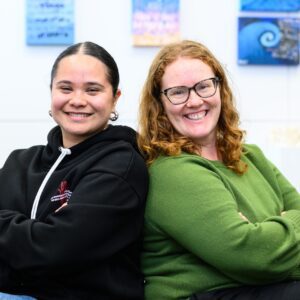
Learning a language isn’t easy, and with cuts to funding there’s even less support for educators to take up the challenge of learning te reo Māori. Meriana Johnsen meets the kaiako at Tawa Intermediate who are going above and beyond to bring more te reo into the classroom.
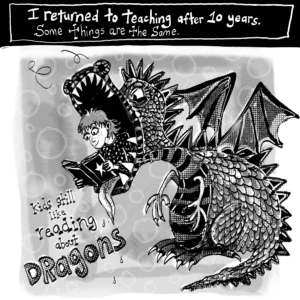
After a decade away from the whiteboard, educator and comic artist Indira Neville has returned to teaching – and she’s drawing about it. In this comic series, Indira shares a glimpse into her days at school, capturing what’s changed, what’s stayed the same and what she never saw coming.
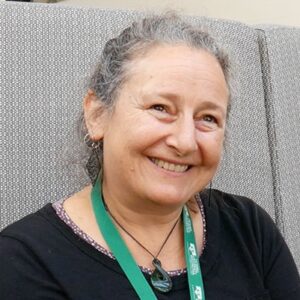
The key obligation for governments is to resource the early childhood care and education sector in order to provide high quality, culturally sustaining provision, since research has reinforced that this serves both individual and societal long-term wellbeing. So why are they not doing this?
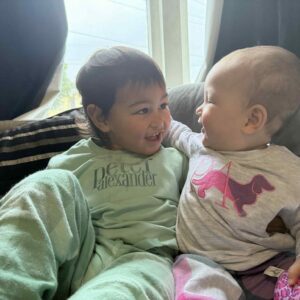
Jasmine Taankink (Ngā Mahanga-a-Tairi) is a second language speaker of te reo Māori committed to the intergenerational transmission of te reo in her whānau and community. She shares with us her hopes for her three moko.